

By, Abraham Ng’hwani,
Founder – Abranova Real Estate.
I embarked on my real estate development career after acquainting myself with engineering and the construction industry, having graduated from Duke and worked for a family-owned conglomerate with an annual turnover of about $4.5 billion. At the time, all I knew about the Build-to-Rent space was that one buys or builds a property and then rents it out — the intention being to create cashflow and asset value appreciation over a period of time.
Although I may still define build-to-rent in the same manner today, I no longer associate it with my childhood experiences of accompanying my late mom on her rent collection escapades as a landlord; I think of build-to-rent in terms of Jonathan Gray of Blackstone, who made a $9.6 billion bet on purchasing single-family homes during the credit crunch of 2008 and turning them into rentals — that was the birth of Invitation Homes Inc. 1
Although I may still define build-to-rent in the same manner today, I no longer associate it with my childhood experiences of accompanying my late mom on her rent collection escapades as a landlord; I think of build-to-rent in terms of Jonathan Gray of Blackstone, who made a $9.6 billion bet on purchasing single-family homes during the credit crunch of 2008 and turning them into rentals — that was the birth of Invitation Homes Inc. 1
Today, Invitation Homes is a dominant player in the rental homes space with assets worth about $17.4 billion — along with other heavy-hitters like American Homes 4 Rent with assets of $9.1 billion. Several firms have been specializing in local build-to-rent markets for years, particularly at ground zero for the build-to-rent trend, the Phoenix metro. For instance, a company like NexMetro pioneered the detached and semi-detached build-to-rent communities in the greater Phoenix area and now has assets under management in excess of $1 billion, 5,000 units and 30 projects — with efforts to expand in the Florida market. 3

Source: American Community Survey, Census Bureau
In a recent research article published by John Burns Real Estate Consulting LLC, which has completed almost 200 new build-for-rent consulting assignments just this cycle alone, agree that:
Recent national survey of single-family rental (SFR) operators provides hard data confirming the migration movement that has been amplified by the pandemic. Permanent work from home permissions, the possibility of more online school in the future, and the need for larger and better configured indoor and outdoor spaces are acting as the accelerants.” 4

In addition, perks such as pet friendly policies, exterior and yard maintenance without the burden of HOA fees make the choice of a single-family or townhome rental a no-brainer to tenants — and they’re likely to stay longer before moving out, if at all. That’s partly because single-family renters have larger families than the average apartment renter.

For investors and home builders, the growing market for build-to-rent tenants provides an abundance of recurring cashflow from monthly rent, value appreciation, and anti-inflation to their capital. There are also several lucrative exit options such as selling your rental portfolio to a REIT, selling to another build-to-rent fund or selling each home apiece to individual buyers. In all these scenarios, investors are likely to exit at a lower cap rate that the going-in cap rate — which means that the potential profits could be sizeable.
The maintenance of a new build-to-rent community is minimal, with major repairs likely to come within 15 to 20 years from Certificate of Occupancy (CO) issuance. Moreover, the homes come with a standard 1-year new construction warranty that’s offered by the general contractor — not to mention the appliances, roof and siding warranties which can range from 2 to 50 years. For-rent homes can be built in contiguous tracts concentrated in specific locations, which allow for bulk-sales to investment funds while making property management a much easier and cost-efficient task — this had always been the main advantage of multifamily over single-family developments, not anymore.
Institutional financiers like Fannie Mae and Freddie Mac have their own share in the growth of the built-to-rent asset class; they’ve been pumping money in subdivisions made up entirely of single-family rental homes. Besides, an increased number of real estate private equity firms are providing end-to-end financing solutions in diversified capital stacks — making it easier for builders and developers to finish and operate the projects until they exit the investment.

How Vertically Integrated Developers Stand to Make the Most Profits in the Built-to-Rent Space.

First units set to open at upscale community by Research Triangle Park (Gallery)

Work set to begin on mixed-use project near RTP featuring townhomes, office space
